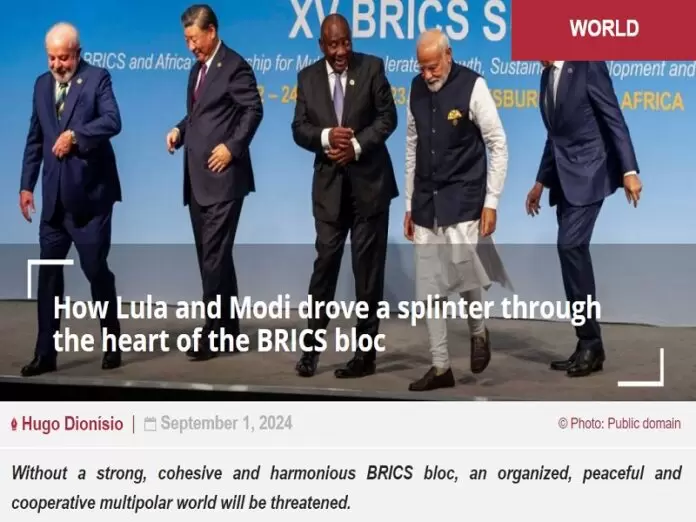BRICS Is A Financial Multipolarity Network, Not An Anti-Western Bloc
The Strategic Culture Foundation (SCF) published a scandalous piece by Hugo Dionisio on Sunday about “How Lula and Modi drove a splinter through the heart of the BRICS bloc”. He began by expressing hope that BRICS could become a cohesive alternative to the West before explaining how Lula and Modi are impeding that. In his view, both leaders are obstacles to the aforesaid goal, which imperils multipolarity. Before going any further, the reader should be aware of a few “inconvenient” facts about BRICS:
* 1 April 2023: “Popular Expectations About BRICS’ New Currency Project Should Be Tempered”
* 27 July 2023: “Alt-Media Is In Shock After The BRICS Bank Confirmed That It Complies With Western Sanctions”
* 3 August 2023: “Russia Is Finally Correcting False Perceptions Of BRICS”
* 17 August 2023: “BRICS Officially Confirmed That It Doesn’t Want To De-Dollarize & Isn’t Anti-Western”
* 21 August 2023: “Lavrov Explained How Russia Envisages BRICS’ Global Role”
* 24 August 2023: “BRICS’ Expansion Is Beneficial But It Also Isn’t Without Strategic Challenges”
* 28 August 2023: “RT Took Care To Clarify India’s Approach Towards BRICS In Order To Avoid Misunderstandings”
* 6 January 2024: “Bridging The Gap Between Russia & Iran’s Differing Views On Whether BRICS Requires A Secretariat”
* 9 March 2024: “BRICS Is Transforming Into A Multipolar Discussion Club & Economic Integration Platform”
* 27 August 2024: “An Indian Source Shed Light On BRICS’ Financial Multipolarity Plans”
The analyses above show that BRICS isn’t so much a “bloc” as it is a “network”, whose purpose isn’t to de-dollarize or challenge the West per se, but to accelerate financial multipolarity processes via voluntarily coordinated policies. BRICS is also comprised of competing pairs of countries like China-India, Egypt-Ethiopia, and Iran-Saudi Arabia, each of which doesn’t want their rival to gain an edge over them through whatever they agree to within this organization. This is especially so for India.
Lula Isn’t As Reliable As Some Might Have Thought
Having clarified that BRICS isn’t exactly what Dionisio described it as, it’s now time to constructively critique his takes on Lula and Modi. His assessment of the Brazilian leader is similar to the more detailed one laid out in this recent analysis about how “Ortega’s Condemnation Of Lula’s Meddling In Venezuela Debunks A Top Alt-Media Lie”. That piece links to over 50 other analyses from October 2022 onward to document Lula’s alignment with some of the US Democrats’ liberal-globalist foreign policy goals.
Clarifying Indian-Ukrainian Relations
While his concerns about Lula are fact-based, the same can’t be said about those that he expressed about Modi. He began that part of his article by referencing The Print’s speculation that Modi’s trip to Kiev last month was partially due to his intent to revive military-technical cooperation. Dionisio wrote that “India is also taking part in the plundering of Ukraine. As it seems from the beginning, Modi was paying tribute in order to be allowed for India to take a share of Ukraine’s national wealth.”
All that actually happened is that they agreed to continue existing cooperation, which is sensible considering India’s dependence on previously Russian-supplied Ukrainian-based naval supply chains. This doesn’t amount to “the plundering of Ukraine” or “paying tribute” but is pragmatic and in consonance with India’s national interests. Even Russian Foreign Ministry spokeswoman Zakharova, who never misses a chance to criticize anything that’s anti-Russian, had nothing negative to say about Modi’s visit.
“Modi’s Trip To Kiev Proved India’s Principled Neutrality In the Ukrainian Conflict”, prior to which “Modi’s Trip To Moscow Was Much More Important Than Most Observers Realize” due to it accelerating tri–multipolarity processes. Readers can learn more about all of that from the four preceding hyperlinked analyses that are beyond the scope of this piece to elaborate on. It’s sufficient to know that India and Russia are on the same page about everything and that no disputes exist in their strategic partnership.
Debunking Claims That India Is Secretly Arming Ukraine
This is important to keep in mind when reading what Dionisio wrote regarding India’s alleged arming of Ukraine. It was explained earlier in the summer why “The Attempt To Revive Interest In Debunked Claims Of Indian Arms Sales To Ukraine Is Suspicious”, which referenced this analysis here from last winter debunking the rumor that India was in talks with Germany for shipping shells to Ukraine. On neither occasion did Russia bite the bait and condemn India like the rumormongers seemingly wanted.
It’s therefore factually false for him to conclude that “India, directly and indirectly, buys military technology and supplies weapons that will be used by the army hired by NATO against Russia. India, now one of the world’s largest military exporters, has a direct interest in the Donbass war. A war waged by NATO against one important friend.” India’s only interest in the conflict is for it to end as soon as possible so as to reduce systemic threats to its fellow Global South partners’ stability.
Dionisio also makes no mention of The Intercept’s report from September 2023 citing leaked documents proving that Pakistan armed Ukraine at America’s behest in exchange for receiving an IMF bailout. This conspicuous omission is either due to him being innocently unaware of this important story or was done deliberately in order to mislead his targeted audience. Whatever the truth may be, this discredits his commentary on South Asian affairs by raising serious questions of his qualifications and intentions.
India Didn’t Sell Brahmos Missiles To The Philippines Behind Russia’s Back
It becomes apparent in the next paragraph that he shouldn’t be opining on these issues after he strongly implied that India sold the BrahMos supersonic cruise missiles that it jointly produced with Russia to the Philippines without Moscow’s permission in order to indirectly pass them along to the US to inspect. There’s no truth whatsoever to that claim and it’s even debunked by the Russian co-director of the BrahMos JV, who boasted about this sale and expressed hope that more will soon follow in the region.
As for why Russia approved this sale, it’s due to the military dimension of Moscow’s envisaged balancing act in Asia, which readers can learn more about in this analysis here from late January. Russia’s “military diplomacy” exports arms to rival states in order to maintain the balance of power between them, reduce the chances of war, and thus improve the odds of a political solution to their disputes. By contrast, the US’ arms disrupt the aforesaid balance to improve its partners’ odds of starting and winning a war.
Regardless of whatever one’s views are about this policy, it objectively exists as proven by Russia’s large-scale military exports to India and Vietnam amidst their respective territorial disputes with China. Many in the Alt-Media Community (AMC) like Dionisio have yet to accept it and might never do so due to their over-simplistic black-and-white worldview, but Russia and China aren’t “allies” against America. They jointly cooperate in accelerating multipolar processes, but differences do indeed exist between them.
A False Paradigm Is Responsible For This Faux Pas
While it’s tempting for well-intentioned observers to imagine that everything unfolding is like a Marvel movie in the sense of there being clearly defined good guys who are all on the same side against the bad guys, the reality of contemporary International Relations is much more complex than that. Dionisio’s description of BRICS as an anti-Western bloc doesn’t hold up to scrutiny, which is the basis upon which a large portion of his worldview and that of many members of the AMC is built.
While his mild critique of Lula is fact-based even though it’s irrelevant in terms of impeding BRICS’ operations like he fears, which is a network whose members voluntarily coordinate the acceleration of financial multipolarity processes and not an anti-Western bloc, his sharp condemnation of Modi is misdirected. There’s no truth to India “plundering” Ukraine, “paying tribute” to it, and having “a direct interest” in perpetuating NATO’s proxy war on Russia through that country by secretly arming Kiev.
It also didn’t sell the jointly Russian-produced BrahMos supersonic cruise missiles to the Philippines without Moscow’s permission like he strongly implied, let alone for the purpose of indirectly passing them along to the US to inspect. Seeing as how a Russian Alt-Media outlet as renowned as the SCF published Dionisio’s falsehoods about India, which is contrary to the spirit of their strategic partnership, they should soon publish a follow-up that sets the record straight in order to avoid a scandal.
Concluding Thoughts
Two surveys from late 2022 and early 2023 showed that Indian youth and adults alike regard Russia as their country’s most reliable partner, yet some might sour on it if they misinterpret what the SCF just did as an impending shift in Russian policy. That outlet’s editors probably share Dionisio’s over-simplistic black-and-white worldview, which misperceives India’s multi–alignment as proof of political unreliability instead of as the global strategic asset that it really is, and that could be why they published it.
Whatever the explanation may be, they should have known that extraordinarily negative claims about an extraordinary close Russian strategic partner require extraordinary evidence if they’re to be passed off as fact by a renowned Russian Alt-Media outlet such as themselves, so they need to take responsibility. Nevertheless, this faux pas might have been what was needed in hindsight to correct his and his editors’ worldview, thus ideally leading to the publication of more accurate analyses about India going forward.








